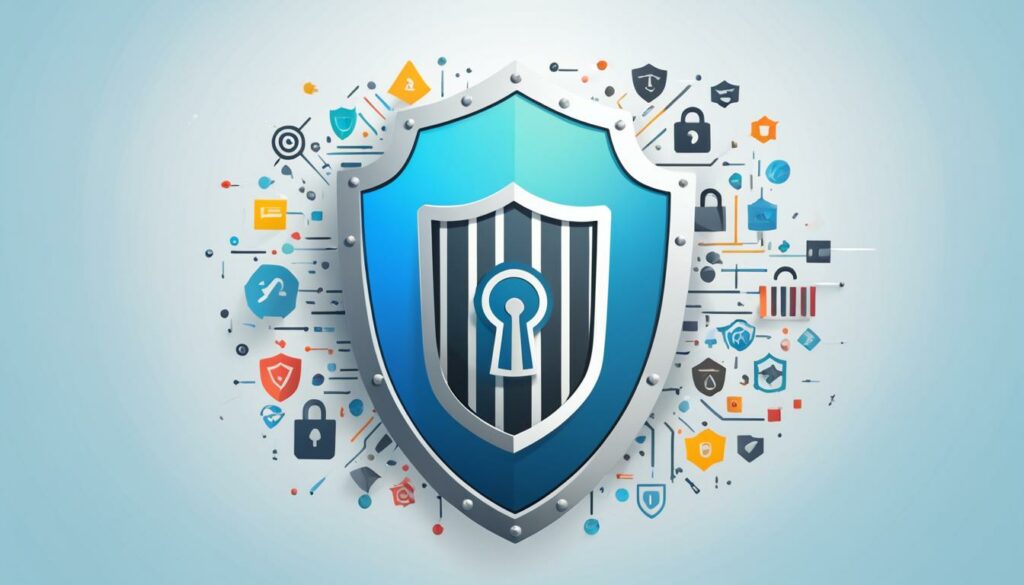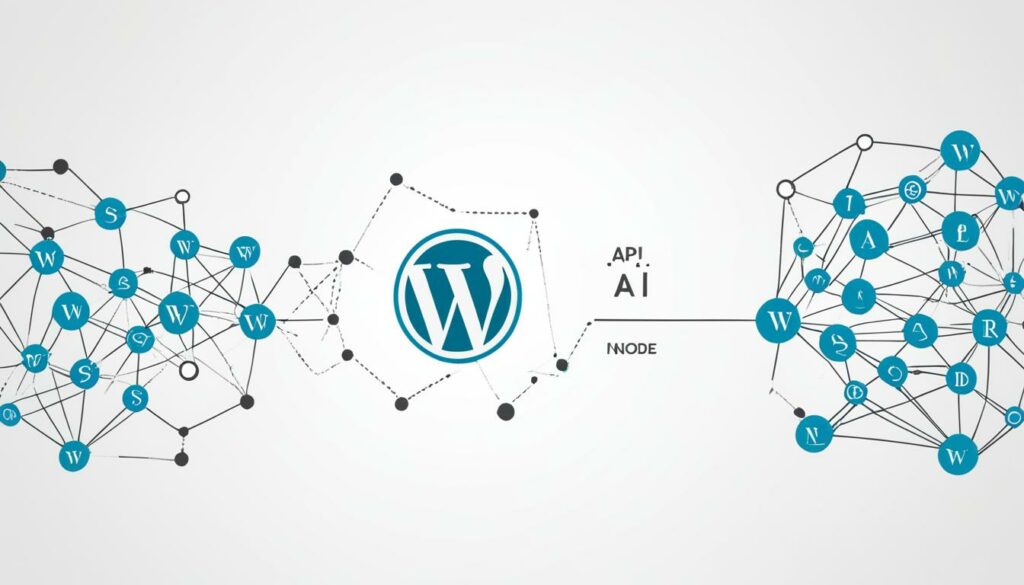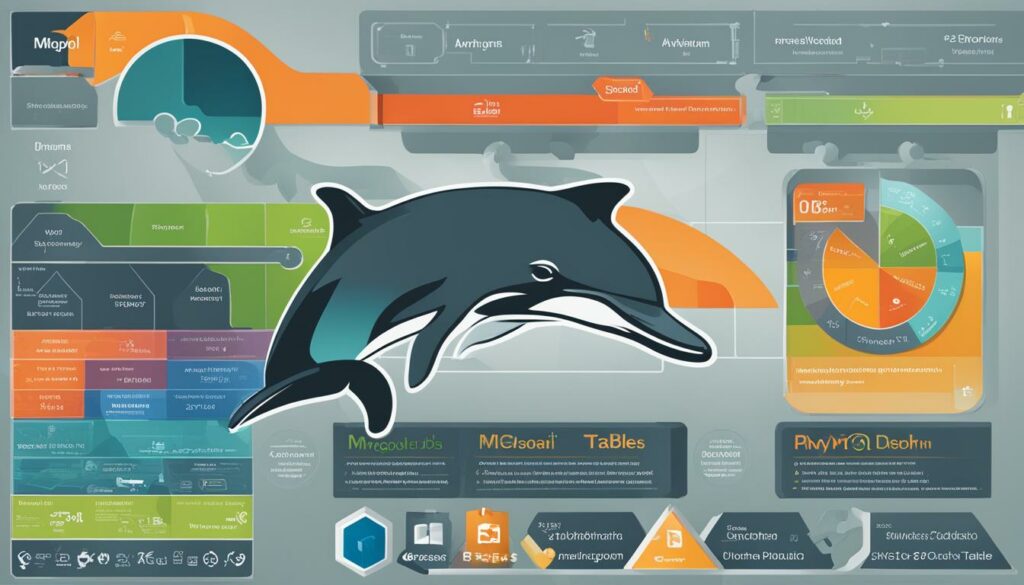WordPress security is a top priority for website owners. With thousands of websites falling victim to malware and phishing attacks every day, it’s crucial to implement the best security practices for your WordPress site. In this guide, we will share advanced techniques to help you protect your website, ensuring that it remains safe and secure.
By following these tips, you can significantly enhance the security of your WordPress site and safeguard it from potential threats. From keeping WordPress updated to using strong passwords and choosing a secure web hosting provider, we will cover all the essential steps to protect your website from unauthorized access and cyber attacks.
Are you ready to dive into the world of advanced WordPress security? Let’s get started!
Key Takeaways:
- Keeping WordPress updated is crucial for maintaining security.
- Using strong and unique passwords helps protect your website from unauthorized access.
- Choosing a secure web hosting provider is essential for a secure WordPress site.
- Regularly backing up your website data is vital for quick restoration in case of security incidents.
- Implementing a web application firewall can help prevent hacking attempts on your website.
Basics of WordPress Security
WordPress is widely recognized for its robust security measures, but there are additional steps you can take to further enhance the security of your website. By implementing these essential WordPress security tips, you can minimize the risk of website vulnerabilities and safeguard your valuable content and user data.
1. Keep WordPress Updated
Regularly updating your WordPress installation, themes, and plugins is crucial for maintaining a secure website. These updates often include security patches that address known vulnerabilities. Stay vigilant and ensure that your WordPress core and all installed themes and plugins are up-to-date.
2. Use Strong Passwords
Choosing strong, unique passwords for your WordPress admin account and other user accounts is vital for preventing unauthorized access. Make sure your passwords include a combination of uppercase and lowercase letters, numbers, and special characters. Avoid common passwords and consider using a password manager to securely store your login credentials.
3. Understand the Role of Web Hosting in Security
Web hosting plays a significant role in WordPress security. Selecting a reputable hosting provider that prioritizes security measures can help protect your website from potential threats. Look for hosts that offer features such as advanced server configurations, regular backups, and automatic malware scanning.
4. Limit User Access and Permissions
Granting appropriate user access and permissions is essential for reducing potential vulnerabilities. Ensure that each user has the appropriate permission level based on their responsibilities. Regularly review and remove unnecessary or inactive user accounts to minimize the risk of unauthorized access.
5. Secure Your WordPress Configuration Files
Protecting sensitive information stored in your WordPress configuration files is crucial. Limit access to these files by setting proper file permissions. Restrict write access to the wp-config.php file, as it contains vital database credentials. Additionally, consider moving the wp-config.php file to a higher-level directory for added security.
“By following these basic WordPress security practices, you can significantly reduce the likelihood of your website falling prey to hackers or other malicious activities.”
Now that we’ve covered the basics of WordPress security, let’s explore more advanced security measures you can implement to further safeguard your website in Section 3: No-Coding WordPress Security Measures.
No-Coding WordPress Security Measures
When it comes to enhancing your WordPress security, you don’t need to be a coding expert. There are several easy steps you can take to protect your website without delving into complex coding techniques. In this section, we will explore simple yet effective measures that can help safeguard your WordPress site against hacking attempts and malware.
Installing a Backup Solution
One crucial aspect of WordPress security is ensuring that you have a reliable backup solution in place. By regularly backing up your website’s data, you can quickly recover in case of an attack or data loss. Numerous WordPress backup solutions are available, offering automated backups and easy restoration options. Make sure to choose a reputable plugin that meets your specific backup needs and schedule regular backups to protect your valuable content.
Using a Security Plugin
A security plugin is an essential tool for fortifying your WordPress site against potential threats. These plugins provide additional layers of protection, actively scanning for vulnerabilities and malware, and offering features like firewall protection, malware removal, and login security. With a wide range of WordPress security plugins to choose from, you can find the one that suits your requirements and complements your existing security measures.
To help you get started, here is a list of popular WordPress security plugins:
- Wordfence Security: This comprehensive security plugin offers firewall protection, malware scanning, login security, and more.
- Sucuri Security: Known for its robust security features, Sucuri provides malware scanning, website firewall, and content delivery network (CDN) services.
- iThemes Security: Formerly known as Better WP Security, this plugin offers various security enhancements, including two-factor authentication, brute force protection, and database backups.
Enabling a Web Application Firewall
Another effective measure to enhance WordPress security is to enable a web application firewall (WAF). WAFs provide an additional layer of defense by filtering out suspicious traffic and blocking malicious attacks such as SQL injections and cross-site scripting (XSS) attempts. These firewalls analyze incoming website traffic, identifying and mitigating potential threats before they reach your site.
Several WordPress security plugins also offer built-in web application firewall functionality. By enabling this feature, you can further bolster your website’s security and minimize the risk of unauthorized access or data breaches.

Implementing these no-coding WordPress security measures can significantly fortify your website’s protection against threats and vulnerabilities. Remember, securing your WordPress site is an ongoing effort, so make sure to keep your plugins, themes, and WordPress core regularly updated, and remain vigilant for any potential security risks.
Advanced WordPress Security Techniques
As an advanced user, you have the opportunity to further enhance the security of your WordPress site with additional techniques. In this section, we will explore some advanced security measures that can safeguard your website from potential threats.
Firstly, changing the default WordPress database prefix can significantly improve security. By modifying the prefix, you make it more difficult for malicious actors to target your database. This simple step can go a long way in fortifying your site’s defenses against potential attacks.
Next, implementing two-factor authentication adds an extra layer of security to your WordPress login process. By requiring users to provide a second form of verification, such as a unique code sent to their mobile devices, you prevent unauthorized access to your website even if passwords are compromised.
It’s also crucial to scan your WordPress site regularly for malware and vulnerabilities. Through thorough scanning, you identify any suspicious files or code that may pose a threat to your website’s security. By addressing these issues promptly, you can prevent potential breaches and keep your site protected.
Remember, advanced WordPress security techniques require proactive measures and ongoing monitoring to ensure optimal protection for your site.
Let’s summarize the advanced WordPress security techniques discussed in this section:
- Change the WordPress database prefix: Modify the default database prefix to add an extra layer of security to your site.
- Implement two-factor authentication: Require users to provide an additional form of verification to enhance login security.
- Regularly scan for malware and vulnerabilities: Conduct thorough scans of your WordPress site to identify and address potential security risks.

Pros and Cons of Advanced WordPress Security Techniques
| Advanced Security Techniques | Pros | Cons |
|---|---|---|
| Changing the WordPress database prefix | Enhanced database security Difficult for attackers to target your site |
Requires technical knowledge to implement |
| Implementing two-factor authentication | Additional layer of login security Protection against compromised passwords |
Users may find it inconvenient May require additional plugins or integrations |
| Regular scanning for malware and vulnerabilities | Identifies potential security risks Promptly addresses vulnerabilities |
Requires regular maintenance and monitoring May generate false positives |
By implementing these advanced WordPress security techniques, you are taking proactive measures to safeguard your website and protect it from potential threats. Remember to regularly update your WordPress core, themes, and plugins, and stay informed about new security practices to keep your site secure.
Fixing a Hacked WordPress Site
If your WordPress site has been compromised by hacking attempts, it is crucial to take immediate action to minimize damage and restore the security of your website. Follow these step-by-step instructions to fix a hacked WordPress site, remove malware, recover your site from backups, and strengthen security measures to prevent future attacks.
Step 1: Identify and Remove Malware
The first step in fixing a hacked WordPress site is to identify and remove any malware that may have been injected into your files. Use a reliable malware scanner or security plugin to scan your WordPress installation thoroughly. Once malware is detected, follow the recommended procedures to remove it completely.
Step 2: Restore from Backups
If you have regular backups of your website, now is the time to restore your WordPress site to a clean, malware-free version. Prioritize restoring files and databases from a backup that was created before the hack. Be cautious during the restoration process and ensure that all necessary files and databases are restored correctly.
Step 3: Strengthen Security Measures
After removing malware and restoring your site, it is essential to strengthen your WordPress site’s security to prevent future hacking attempts. Here are some recommended security measures:
- Update WordPress core, themes, and plugins regularly to ensure you have the latest security patches.
- Choose strong, unique passwords for all user accounts, including administrators, editors, and contributors.
- Disable file editing through the WordPress dashboard to prevent unauthorized code modifications.
- Enable two-factor authentication for added security during login.
- Use a reliable security plugin to monitor and protect your website from potential threats.
- Regularly scan your WordPress site for malware using security plugins or online scanning tools.
Step 4: Implement Web Application Firewall (WAF)
To further enhance the security of your WordPress site, consider implementing a web application firewall (WAF). A WAF acts as a shield between your website and potential attackers, blocking malicious traffic and protecting against common hacking techniques. There are several WAF solutions available, both free and premium, which can help fortify your site’s defenses.
“Fixing a hacked WordPress site requires a combination of malware removal, site recovery, and proactive security measures to prevent future attacks.”
By following these steps and being proactive in securing your WordPress site, you can recover your hacked website and safeguard it against future threats.
| Step | Description |
|---|---|
| Step 1 | Identify and Remove Malware |
| Step 2 | Restore from Backups |
| Step 3 | Strengthen Security Measures |
| Step 4 | Implement Web Application Firewall (WAF) |

The Importance of WordPress Security for SEO
Website security is an essential aspect of maintaining a successful online presence. It not only protects your data and users but also plays a significant role in your SEO performance. When it comes to WordPress security, prioritizing it can have a positive impact on your website’s search engine rankings and overall reputation.
One of the key considerations in WordPress security and SEO is the impact of malware on your website. Malware can have detrimental effects on your SEO efforts, leading to a decrease in search engine rankings and a tarnished website reputation. Search engines like Google prioritize user safety and are quick to blacklist websites with malware, causing a significant drop in organic traffic.
Malware-infected websites can experience a significant decrease in organic traffic, leading to loss of potential customers and revenue.
Not only does malware affect your website’s visibility in search engine results, but it also damages your website’s reputation. Visitors who encounter a security warning or malware-infected pages are less likely to trust your website, compromising your online credibility. Building a reputable online presence requires a secure and trustworthy website that prioritizes the safety of its users.
Improving WordPress security directly contributes to your SEO success. By implementing robust security measures, you safeguard your website against potential malware attacks, ensuring uninterrupted search engine visibility and safeguarding your website reputation. Search engines prioritize secure websites, ensuring that users have a safe browsing experience.
When your website is secured against malware, Google and other search engines will reward you with better rankings and improved visibility. This means a higher chance of attracting organic traffic, generating leads, and converting them into loyal customers.
Protecting Your Website Reputation with WordPress Security
To understand the importance of WordPress security for maintaining a positive website reputation, let’s consider the following:
- Malware impacts user experience: Malware-infected websites can lead to a poor user experience, causing frustration and dissatisfaction among visitors.
- Negative reviews and complaints: A compromised website can result in negative online reviews and customer complaints, damaging your online reputation.
- Data breaches and privacy concerns: If your website’s security is breached, it puts user data at risk. This not only affects your website reputation but can also put you at legal risk.
By prioritizing WordPress security, you protect your website’s reputation, ensuring a positive user experience and building trust among your audience. A secure website reflects professionalism, reliability, and a commitment to customer satisfaction, ultimately boosting your online reputation.
The Importance of Regular Security Audits
To maintain the security and SEO performance of your WordPress site, it’s crucial to conduct regular security audits. These audits help identify vulnerabilities, detect malware, and ensure that your security measures are up to date.
During a security audit, you can:
- Scan your website for malware and suspicious activities
- Update your WordPress core, plugins, and themes to their latest versions
- Implement additional security measures such as two-factor authentication and web application firewalls
- Check for any vulnerabilities that hackers could exploit
- Backup your website to protect against data loss
A regular security audit allows you to stay one step ahead of potential security threats, ensuring that your website remains highly secure and continuously optimized for search engines.
The Bottom Line
WordPress security is not just about protecting your website and users, but also about maintaining good SEO performance and a positive website reputation. By investing in robust security measures, regularly auditing your website’s security, and addressing any vulnerabilities promptly, you can safeguard your website’s visibility, attract organic traffic, and build a reputable online presence.
WordPress Security Best Practices for Marketers
As a marketer, you understand the importance of protecting sensitive customer data and confidential information. In the digital age, where cyber threats are on the rise, implementing robust WordPress security measures is essential. By following these best practices, you can safeguard your customers’ information and maintain the trust they have in your brand.
1. Encrypt Your Data
Encrypting data adds an extra layer of protection to the information you collect from customers. By using secure encryption methods, you can ensure that even if unauthorized individuals gain access to your database, the data remains unreadable and meaningless to them.
2. Implement Strong Access Controls
Controlling access to sensitive data is crucial to prevent unauthorized individuals from compromising your customers’ information. Set up strong access controls by utilizing strong passwords, enabling two-factor authentication, and limiting user privileges. This way, only authorized personnel can access and manage the data.
3. Regularly Update Plugins and Themes
Plugins and themes are vital components of any WordPress site, but they can also be potential entry points for hackers if not regularly updated. Stay vigilant by keeping your plugins and themes up to date with the latest security patches and bug fixes. Regularly check for updates and apply them promptly.
4. Backup Your Data
A robust backup solution is essential in case of any security breaches or data loss incidents. Regularly back up your WordPress site and make sure your backups are stored securely, preferably in an off-site location or on a trusted cloud service. This way, you can quickly restore your site and minimize any potential damage.
“By following these best practices, you can safeguard your customers’ information and maintain the trust they have in your brand.”
Implementing these WordPress security best practices will not only protect your customers’ information but also safeguard your brand reputation. By taking proactive steps to secure sensitive data, controlling access, and regularly updating your site, you can stay one step ahead of potential security threats and ensure your customers’ trust remains intact.
Proactive Measures to Enhance WordPress Security
Taking proactive measures is essential to ensure ongoing security for your WordPress site. Protecting your website from potential security threats requires a combination of preventive actions and regular security checks. By implementing the following tips, you can significantly enhance the security of your WordPress site and safeguard it from potential vulnerabilities.
Securing Plugins and Themes
One of the key proactive measures to strengthen your WordPress security is securing your plugins and themes. Outdated or poorly coded plugins and themes can create vulnerabilities that hackers can exploit.
Here are some steps you can take to secure your plugins and themes:
- Regularly update plugins and themes to their latest versions, as developers often release security patches and bug fixes.
- Disable and remove any unused plugins and themes to minimize potential attack surfaces.
- Choose plugins and themes from reputable sources, such as the official WordPress repository or trusted developers.
- Keep track of plugin and theme vulnerabilities by subscribing to credible security alerts and news.
Regular Security Checks
Regular security checks are crucial to maintaining the integrity of your WordPress site. By periodically reviewing your site’s security, you can identify and address any vulnerabilities or suspicious activities promptly.
Consider the following actions as part of your regular security checks:
- Perform regular malware scans using reliable security plugins.
- Monitor your site’s access logs to detect any unusual login attempts or suspicious activities.
- Check for outdated software, including WordPress core, plugins, and themes, and update them as necessary.
- Implement strong password policies for all user accounts, encouraging the use of unique, complex passwords.
Implementing Security Headers
Security headers provide an additional layer of protection against potential security threats. By configuring security headers, you can enhance your WordPress site’s resilience to various types of attacks, such as cross-site scripting (XSS) and clickjacking.
Consider implementing the following security headers:
- Strict-Transport-Security (HSTS) to ensure secure connections and prevent SSL/TLS downgrade attacks.
- Content-Security-Policy (CSP) to define the allowed sources of content and mitigate the risks of code injection attacks.
- X-Frame-Options to prevent your site from being loaded within an iframe, protecting against clickjacking.
By proactively securing your WordPress plugins and themes, conducting regular security checks, and implementing security headers, you can fortify your website’s defense against potential security threats. Stay vigilant and keep your WordPress site protected to ensure a safe online presence.
The Role of WordPress Analytics in Enhancing Security
WordPress analytics is an essential tool for website owners looking to maximize their site’s security. By utilizing analytics data, you can gain valuable insights into your website’s performance and identify potential security vulnerabilities. These insights allow you to make data-driven decisions and take proactive measures to further enhance the security of your WordPress site. Let’s explore how WordPress analytics can help you track website metrics and strengthen your website’s security.
Tracking Website Metrics
One of the key benefits of using WordPress analytics is the ability to track various website metrics. By monitoring metrics such as page views, bounce rate, and average session duration, you can gain a better understanding of your website’s overall performance. This data can reveal any unusual activity or potential security threats, helping you quickly identify and address security issues before they escalate.
Moreover, tracking website metrics allows you to assess the effectiveness of your security measures and determine if any adjustments or improvements are needed. For example, if you notice a sudden increase in bounce rate or a decrease in average session duration, it could indicate that visitors are encountering security-related issues that need to be addressed promptly.
Identifying Potential Security Vulnerabilities
WordPress analytics can also help you identify potential security vulnerabilities within your website. Through advanced tracking and analysis, you can uncover patterns or anomalies that may indicate security risks. For instance, if you notice a significant increase in failed login attempts or suspicious user behavior, it could be a sign of attempted unauthorized access or a potential hacking attempt.
By regularly monitoring and analyzing your analytics data, you can detect these security vulnerabilities early on and take the necessary steps to mitigate the risks. This may include implementing additional security measures, updating plugins and themes, or strengthening user authentication protocols.
Optimizing Security with Data-Driven Decisions
With WordPress analytics, you can make data-driven decisions to optimize your website’s security. By analyzing the data generated by your analytics tool, you can gain insights into which security measures are most effective and which areas require improvement. This data-driven approach allows you to allocate your resources more efficiently and focus on implementing security measures that have a higher likelihood of success.
For example, if you find that the majority of security breaches occur due to outdated plugins, you can prioritize regular plugin updates and ensure you have a well-defined process for monitoring vulnerabilities and applying patches. Similarly, if your analytics data indicates that a particular page or section of your website is frequently targeted by hackers, you can invest more resources in securing that specific area.
Conclusion
In conclusion, implementing strong security measures is crucial for safeguarding your WordPress site from potential threats and ensuring the protection of your website and user data. By following the advanced techniques and best practices discussed in this guide, you can significantly enhance the security of your WordPress site.
Remember to regularly update your WordPress core, themes, and plugins to mitigate any security vulnerabilities that may arise. Furthermore, using strong and unique passwords for your accounts, enabling two-factor authentication, and implementing a web application firewall can provide an additional layer of protection against potential hacking attempts.
Additionally, don’t forget to regularly scan your WordPress site for malware and suspicious activity, and make use of analytics to track and improve security performance. By being proactive and keeping a close eye on your website’s security, you can minimize the risk of security breaches and ensure the continued safety and integrity of your WordPress site.
FAQ
Q: What are some advanced techniques to maximize WordPress security?
A: Some advanced techniques to maximize WordPress security include keeping WordPress updated, using strong passwords, choosing a secure web hosting provider, and implementing two-factor authentication.
Q: What are the basics of WordPress security?
A: The basics of WordPress security include keeping WordPress updated, using secure passwords, and understanding the role of web hosting in security.
Q: Are there any security measures I can implement without coding knowledge?
A: Yes, you can enhance your WordPress security without coding knowledge by installing a backup solution, using a security plugin, and enabling a web application firewall.
Q: What are some advanced techniques to improve WordPress security?
A: Advanced techniques to improve WordPress security include changing the default “admin” username, disabling file editing, and implementing two-factor authentication. You can also scan your WordPress site for malware and vulnerabilities.
Q: What should I do if my WordPress site has been hacked?
A: If your WordPress site has been hacked, you should take immediate action to remove malware, recover your site from backups, and strengthen security measures to prevent future attacks.
Q: How does website security impact SEO?
A: Security breaches, such as malware, can have negative effects on search engine rankings and website reputation. Improving WordPress security can help boost your SEO efforts.
Q: What are some WordPress security best practices for marketers?
A: WordPress security best practices for marketers include encrypting data, implementing strong access controls, and regularly updating plugins and themes.
Q: What proactive measures can I take to enhance WordPress security?
A: To enhance WordPress security proactively, you should secure plugins and themes, conduct regular security checks, and implement security headers.
Q: How can WordPress analytics help enhance security?
A: WordPress analytics can provide valuable insights into your website’s performance and security. By utilizing analytics, you can identify potential security vulnerabilities, track website metrics, and make data-driven decisions to enhance the security of your WordPress site.












